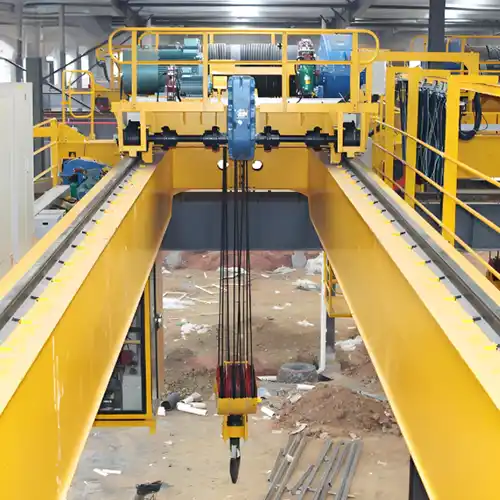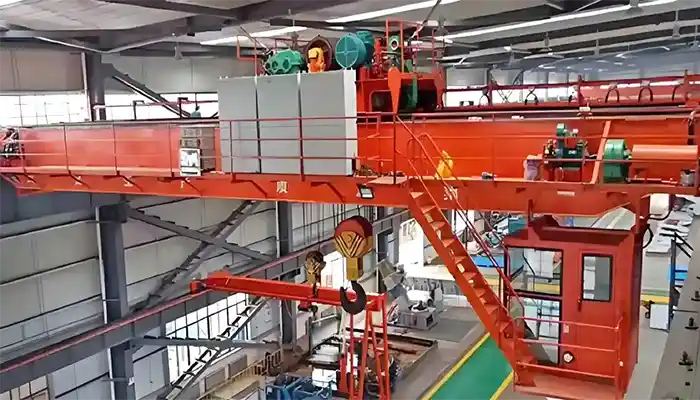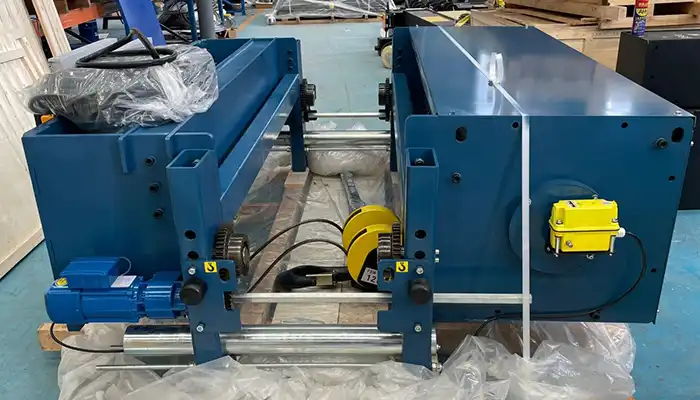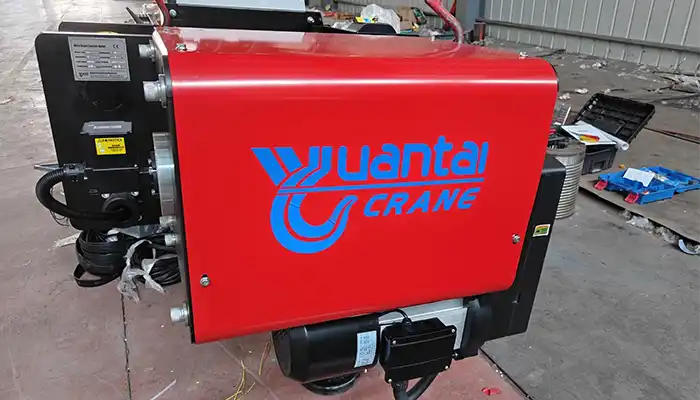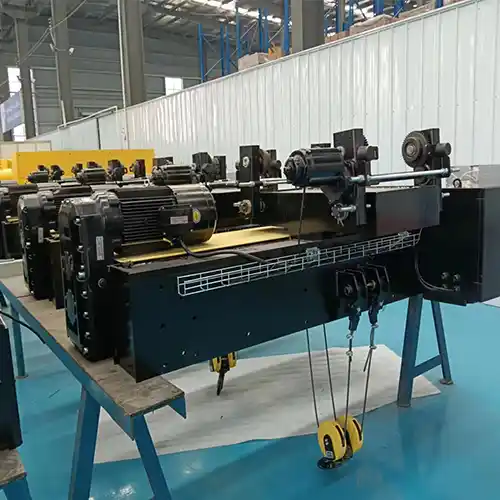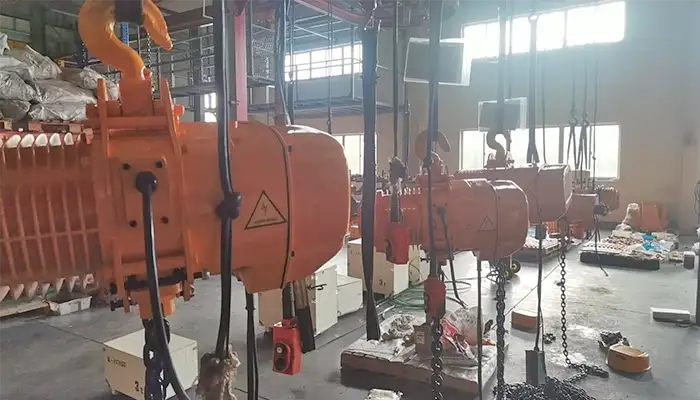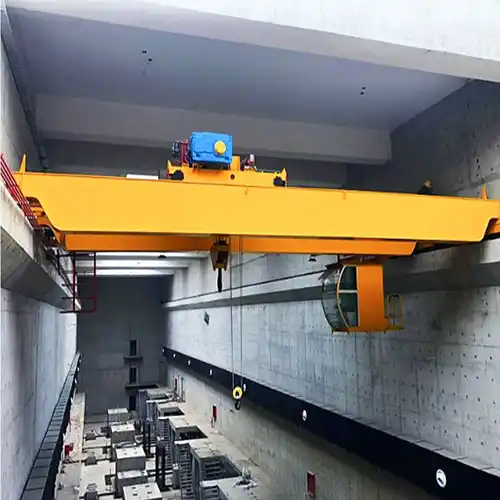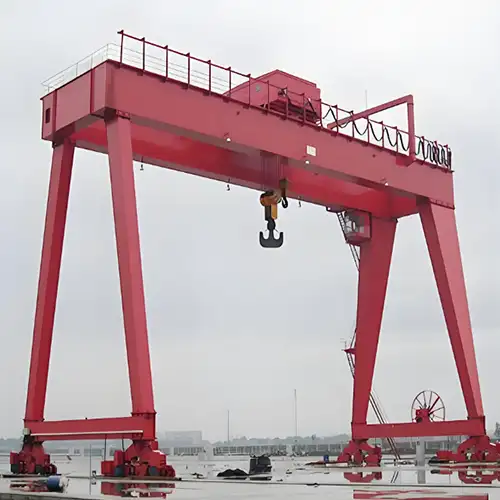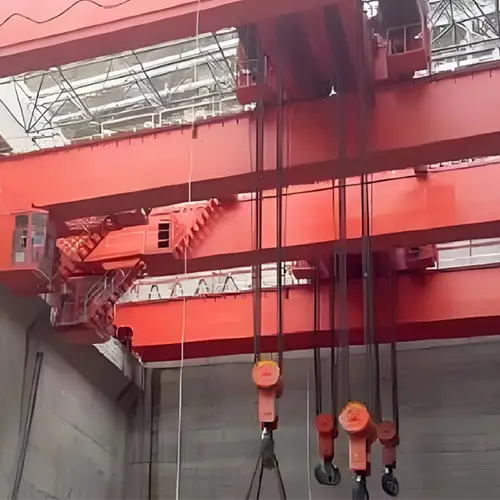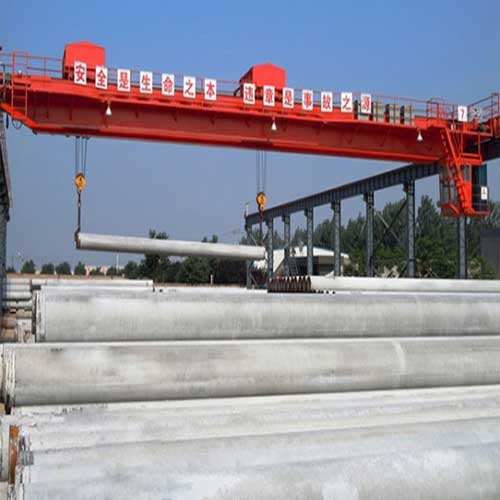QD Heavy Duty Bridge Cranes with Open Winch Hot Sale 5 Ton to 100 Ton
Heavy duty QD double girder bridge cranes with open winch trolley, hot sale capacity 5 ton to 100 ton customized for your needs.
Category: Heavy Duty & Large Capacity
Your Trusted Heavy Duty Overhead Crane Manufacturer & Supplier
QD Heavy Duty Overhead Bridge Cranes with Open Winch 5 Ton to 100 Ton
High-performance QD double girder cranes with open winch trolley, offering reliable lifting solutions for various industrial applications.
Overview of Double Girder Bridge Cranes with Open Winch Trolley
Double girder bridge cranes are designed with two parallel beams (girders) that provide robust support for lifting heavy loads across a large span. These cranes are typically used in heavy-duty applications where high lifting capacities and large spans are required. The open winch trolley system is a key component of this crane type, consisting of a trolley that moves along the girder, carrying the hoist and lifting mechanism. This system allows for efficient, precise movement of loads, offering versatility in handling large or irregularly shaped materials.
- Double Girder Design: The two girders allow for greater lifting capacity, more stability, and the ability to span larger areas than a single girder crane.
- Open Winch Trolley System: The open winch trolley allows the crane operator to control the lifting process with high accuracy. It is ideal for demanding lifting tasks, offering greater flexibility and precision in operations.
Importance of the Open Winch Trolley System in Heavy-Duty Lifting Operations
The open winch trolley plays a crucial role in maximizing the performance of double girder bridge cranes. It supports the hoist and lifting mechanism, enabling smooth and efficient operation across a wide range of industrial tasks. Its benefits include:
- Efficiency in Load Handling: The open winch trolley reduces friction and wear, which increases the overall efficiency of the crane. It provides smooth movements and reliable load handling, making it ideal for high-frequency use.
- Increased Reach and Flexibility: The open winch trolley system allows the crane to handle loads at greater heights and spans, which is critical for large facilities, manufacturing plants, or construction sites with complex lifting needs.
- Versatility in Lifting: The system enables precise control over lifting, making it suitable for applications that involve irregularly shaped loads, sensitive materials, or require fine-tuned load positioning.
Key Features of Double Girder Bridge Cranes with Open Winch Trolley
Design & Structure
Double Girder Bridge Configuration
- Enhanced Stability: The double girder setup improves overall stability, allowing these cranes to safely lift massive, heavy loads without compromising on performance.
- Increased Capacity: Thanks to the robust structure, double girder cranes can handle anywhere from 5 tons to 100 tons and beyond. This makes them ideal for heavy-duty industrial work.
Open Winch Trolley System
The open winch trolley is the part of the crane that moves the load along the girder. It's built for precision and smoothness. The open design reduces friction, ensuring that the trolley moves effortlessly along the track, even when lifting large or oddly shaped items.
- Smooth, Precise Movement: The open winch trolley allows for smooth, controlled movement of loads, making it easier to handle materials with accuracy—whether you're moving delicate parts or large, heavy equipment.
- Versatility: This system is versatile enough to handle all kinds of loads, from steel beams to machinery parts, making it a go-to for various industries.
Open Winch Trolley System: Smooth and Precise Load Movement
What is the Open Winch Trolley?
The open winch trolley is the mechanism that moves the load along the girder. Its open design reduces friction, making the trolley move smoothly and efficiently, even when lifting heavy or irregularly shaped loads. This design is all about precision, ensuring that loads are moved exactly where they need to go without the risk of swaying or instability.
- Smooth, Precise Movement: The open winch trolley ensures that even heavy or delicate materials can be handled with accuracy. Whether you're lifting steel plates or moving a massive generator, the trolley allows for smooth, controlled lifting.
- Versatility: This system can easily handle a variety of loads—ranging from steel beams to machine components. Its flexibility makes it an ideal choice for industries like construction, manufacturing, and shipbuilding where different types of materials need to be lifted and moved.
The open winch trolley isn't just about moving loads—it's about doing so efficiently and with precision, enhancing both the crane's performance and the safety of its operations.
Why These Features Matter
Together, the double girder configuration and open winch trolley system form the perfect combination for tackling the toughest lifting tasks. These cranes are designed to provide maximum stability, high lifting capacity, and precise load handling. Whether you're lifting large industrial equipment or delicate materials, the combination of these features ensures your crane operates at its best.
- The double girder design enhances both stability and capacity, allowing for heavy-duty work without sacrificing safety.
- The open winch trolley ensures smooth operation, minimizing wear and tear while improving accuracy in load handling.
These features make double girder bridge cranes with open winch trolleys a go-to solution for industries requiring reliable, efficient, and safe lifting equipment.
Lifting Capacities
Double girder bridge cranes with open winch trolleys come in a wide range of lifting capacities, from 5 tons to 100 tons or more. Here's how these different capacities break down:
- 5 to 10 Tons: These cranes are commonly used in smaller, more moderate lifting operations, such as moving equipment and parts in manufacturing plants or automotive assembly lines.
- 16/3.2 Tons: This is perfect for medium-duty tasks. It often comes with dual-hook configurations, so it's ideal for handling multiple types of loads at the same time—great for industries like heavy manufacturing or steel production.
- 50/10 Tons: These cranes are heavy-duty workhorses. They're commonly used in steel mills, power plants, and heavy equipment manufacturing, where you need to lift large, heavy materials like steel coils or generators.
- 100/20 Tons: If you're in a large-scale operation like shipbuilding or construction, these cranes can handle the truly big jobs. Whether it's ship components or large construction beams, these cranes do it all.
Control Options for Double Girder Bridge Cranes with Open Winch Trolley
Choosing the right control system for your crane is crucial for ensuring efficiency, safety, and ease of operation. These cranes offer several control options tailored to different types of operations. Here's a breakdown of the most common control systems and when to use each:
Pendant Control
Pendant control is one of the simplest and most straightforward crane control systems. It allows the operator to manage the crane's movements using a hand-held device. This system works well for smaller operations where the crane is often close to the operator.
Best For:
- Smaller operations or environments with limited space.
- Simpler lifting tasks where the operator needs to stay close to the crane and have direct control over movements.
Benefits:
- Easy to use and doesn't require complicated setup.
- Provides direct control over the crane's functions, making it ideal for small, repetitive lifting jobs.
Remote Control
Remote control offers greater flexibility by allowing operators to control the crane from a distance. This is particularly beneficial in larger or busier work environments, where safety and ease of operation are a priority.
Best For:
- Large-scale operations such as construction sites, warehouses, or logistics centers where the operator may need to move around.
- Busy work areas where crane movement needs to be monitored and controlled from a safe distance.
Benefits:
- Increases safety by keeping the operator at a distance from the crane.
- Offers flexibility to move freely around the job site while still controlling the crane's operations.
Cabin Control
For the most demanding operations, cabin control is the preferred choice. The operator sits inside a cabin on the crane, providing them with a clear, unobstructed view of the load and work area. This option is ideal for complex lifting tasks where precision and visibility are critical.
Best For:
- Large operations where visibility and control are paramount, such as in manufacturing plants or large infrastructure projects.
- Complex lifting tasks that require precise maneuvering of heavy or oversized loads.
Benefits:
- Offers the best visibility, improving the operator's ability to safely and efficiently control the crane.
- Allows for complete control of the crane's functions, especially in challenging lifting environments.
By selecting the right control system for your operation, you can ensure smoother crane performance, improved safety, and greater operational efficiency. Whether you choose pendant, remote, or cabin control, each option is designed to suit different types of work environments and lifting needs.
Durability & Safety Features of Double Girder Bridge Cranes with Open Winch Trolley
When you're lifting heavy loads, especially in demanding environments, durability and safety are paramount. Double girder bridge cranes with open winch trolleys are specifically designed to handle these challenges, ensuring reliable and secure lifting over the long term. Here's a look at the key features that make these cranes both durable and safe:
Overload Protection
Overload protection is a crucial safety feature that prevents the crane from lifting a load beyond its rated capacity. This ensures that both the crane and the operator are protected from the risks of overloading, which could lead to equipment failure or accidents.
Why It Matters:
- Prevents structural damage to the crane.
- Ensures operator safety by reducing the likelihood of dangerous lifting conditions.
- Avoids costly repairs and downtime caused by overloading.
Anti-Sway Systems
Lifting large or irregularly shaped loads often introduces the risk of load swinging or swaying. Anti-sway systems are designed to minimize this movement, stabilizing the load as it's lifted, moved, and lowered.
Why It Matters:
- Increases stability of heavy or awkwardly shaped loads.
- Reduces the risk of accidents due to uncontrolled swinging or tipping.
- Enhances precision in operations, particularly in crowded or constrained environments.
Fail-Safe Features
Fail-safe mechanisms are integrated into the crane's design to ensure it can safely stop or operate in the event of a malfunction. These systems automatically engage in case of electrical or mechanical issues, ensuring that the crane doesn't become a hazard.
Why It Matters:
- Minimizes risk by ensuring the crane can safely shut down or operate if something goes wrong.
- Protects both the crane and the operators, ensuring no dangerous situations arise unexpectedly.
- Increases the longevity of the crane by preventing damage due to unforeseen malfunctions.
Overhead Electric Winch Crane Built for Safety and Longevity
By integrating these advanced safety and durability features, double girder bridge cranes with open winch trolleys offer superior performance even under the most demanding conditions. Whether for manufacturing, construction, or shipbuilding, these cranes are designed to handle heavy lifting safely, efficiently, and reliably—ensuring maximum uptime and operator confidence in the long run.
Hot Sale Capacities of Double Girder Bridge Cranes with Open Winch Trolley

5 Ton Capacity
Applications:
- Manufacturing: Lifting smaller parts, machinery components, and light equipment on production lines.
- Automotive Assembly: Ideal for moving engine parts, chassis, and small assembly line components.
- Light Construction: Suitable for lifting materials like concrete, wood, and steel in smaller-scale construction projects.
This capacity is great for operations that need moderate lifting power for lighter materials and smaller parts.

10 Ton Capacity
Applications:
- Warehouses: Handling heavier goods, pallets, and construction materials.
- Logistics: Efficient for loading and unloading shipments at distribution centers.
- Material Handling: Lifting large storage containers, factory equipment, and bulky parts.
When you need more reach and power, the 10-ton capacity provides that extra capability, ideal for tasks requiring a bit more muscle.
16/3.2 Ton Capacity
Key Feature: Dual-Hook Configuration for lifting multiple loads at the same time.
Applications:
- Heavy Manufacturing: Lifting large parts like steel plates, beams, or irregularly shaped items.
- Steel & Automotive Industries: Perfect for tasks involving precise, heavy lifting of multiple types of loads simultaneously.
This capacity offers great flexibility and is ideal for industries with complex lifting needs.
20/5 Ton Capacity
Key Feature: Dual-Load Capability allows the lifting of light and heavy loads together.
Applications:
- Heavy Equipment Manufacturing: Moving large machine components such as engines, frames, and mechanical parts.
- Automotive Manufacturing: Efficient for transporting engine blocks, chassis, and body panels across assembly lines.
The 20/5-ton capacity is versatile and well-suited for tasks that require lifting both heavy and lighter loads at the same time.

20 ton heavy duty overhead bridge crane

20/5 ton overhead crane double girder with double hooks
32/5 Ton Capacity
Applications:
- Manufacturing Plants: Handling heavy machinery, large equipment, and oversized parts.
- Construction: Lifting steel beams, concrete blocks, and large structural components.
- Shipbuilding: Moving massive ship components like hull sections, engines, and propulsion systems.
Designed for more demanding industrial environments, the 32/5-ton capacity excels in heavy-duty applications requiring frequent and large lifts.

32 ton heavy duty open winch overhead crane

50/5 ton double girder overhead crane with open winch , main hook and axuliary hook
50/10 Ton Capacity
Applications:
- Steel Mills & Foundries: Lifting heavy steel coils, slabs, or molten metal containers.
- Power Plants: Moving large turbines, generators, and electrical components.
- Large-Scale Construction Projects: Lifting heavy machinery and construction beams for major infrastructure projects.
With its heavy-duty capacity, the 50/10-ton crane is built for industrial environments where maximum lifting power is needed.

50/5 ton double girder overhead crane with open winch , main hook and axuliary hook

50/10 ton overhead crane for heavy material handling with 50 ton hook and 10 ton hook
75/20 Ton Capacity
Applications:
- Heavy Construction: Lifting steel beams, concrete panels, and large construction materials.
- Industrial Projects: Handling heavy machinery and large-scale items in factories or construction sites.
The 75/20-ton crane is ideal for high-precision lifting of large materials, commonly used in major construction and industrial projects.

75/10 ton overhead crane for heavy lifting

80 ton overhead crane with open winch trolley for reference
100/20 Ton Capacity
Applications:
- Steel Manufacturing: Lifting large steel rolls, billets, and other bulky materials.
- Shipbuilding: Moving large ship components like engines, hull parts, and structural sections.
- Large Machinery Assembly: Handling massive components for assembling large industrial machinery like turbines and generators.

250 ton overhead crane for heavy material handling

320 ton/50 ton overhead crane for reference
This high-capacity crane is designed for lifting exceptionally heavy and large loads in the toughest industrial settings, such as steel manufacturing and shipbuilding.
Each of these capacities has a specific role in heavy-duty industries, from small to medium-sized operations to large-scale industrial projects. By selecting the right capacity for your lifting needs, you can optimize efficiency, safety, and productivity in your operations.
How to Confirm the Right Capacity for Your Application
Identify Load Requirements
The first step in choosing the right crane capacity is to determine the heaviest load you will need to lift.
- Weight & Size: Make sure to accurately assess the weight and size of the heaviest load you'll be lifting. This is the core factor in selecting the crane's lifting capacity.
- Load Shape & Type: Consider whether the load is irregular in shape or made up of multiple components. For example, if you're lifting long beams, heavy machinery parts, or multiple small components, you may need a dual-hook configuration or a magnetic lifting system.
Knowing the specifics of your load will help you avoid under-sizing or over-sizing the crane.
Assess Operational Space
The next factor to consider is the available space in your facility or job site.
- Space Constraints: Larger cranes with higher lifting capacities typically require more overhead space. Make sure there is enough clearance in your facility or work site to accommodate the crane's dimensions, including the hook height and travel distance.
- Lifting Height & Reach: Higher-capacity cranes often come with more vertical reach and horizontal movement. If you need to lift large materials or place them across long distances, make sure your crane has the lifting height and horizontal reach to meet your operational needs.
Evaluate Work Environment
The environment in which the crane operates can significantly affect its performance and lifespan.
- Environmental Factors: Assess temperature, humidity, and potential exposure to corrosive environments. For example, if the crane will be used in outdoor, high-humidity, or chemical-rich environments, you'll need a model with anti-corrosion protection and components designed for harsh conditions.
- Heavy-Duty Needs: For cranes that will undergo high-frequency lifting or will be used in extreme environments, opt for heavy-duty cranes with higher capacities. These models are designed to withstand wear and tear and ensure long-term performance under tough conditions.
Consult with Manufacturers
Finally, always work closely with crane manufacturers or suppliers to ensure you get the right crane for your needs.
- Load Charts & Capacity Calculators: Use the load charts and capacity calculators provided by the manufacturer to check the crane's capabilities. This will give you an accurate understanding of its lifting potential, reach, and overall performance specifications.
- Customization Options: If your application requires specific features not offered in the standard models, discuss customization options. Manufacturers can often provide tailored solutions to meet unique lifting demands, ensuring that the crane fits perfectly with your operations.
By following these steps, you can confidently choose the right double girder bridge crane with an open winch trolley and the appropriate lifting capacity for your application, ensuring smooth and efficient operations.
Applications for Each Hot Sale Capacity
5-10 Ton Cranes
Applications:
- Light Assembly: Ideal for assembling smaller parts and components in production lines.
- Parts Handling: Perfect for moving smaller machinery parts or equipment between different workstations.
- Small Machinery Movements: Used to lift and transport small machinery or tools within a facility.
- Material Transportation: Efficient for lifting and moving materials like steel plates, concrete, or building materials in smaller-scale projects.
Industries:
- Manufacturing: Common in factories for lifting smaller components or materials in production lines.
- Automotive: Widely used for moving engine parts, chassis, and smaller vehicle components in assembly plants.
- Logistics: Ideal for transporting pallets, boxes, and lightweight goods in warehouses or distribution centers.
- Light Construction: Used in small construction sites to lift light building materials such as wood, steel beams, and concrete panels.
16/3.2-32/5 Ton Cranes
Applications:
- Heavy Lifting in Manufacturing Plants: Used for lifting larger machinery parts, heavy equipment, or steel materials in factories.
- Handling Steel: Efficient for moving steel plates, coils, beams, or rods in steel manufacturing or fabrication plants.
- Large Machinery: Ideal for lifting heavy machinery components such as engines, turbines, and large mechanical parts.
- Construction Materials: Lifting large and heavy construction materials like steel beams, concrete blocks, and structural components.
Industries:
- Steel Manufacturing: Used to handle heavy steel coils, slabs, and plates in mills and fabrication plants.
- Automotive Assembly: Ideal for lifting larger components in vehicle manufacturing, such as engine blocks, frames, and body panels.
- Construction: Essential for lifting large construction materials, like beams and concrete, in both infrastructure and building projects.
- Shipbuilding: Used for handling ship components such as hull sections, engines, and large machinery in shipyards.
50/10-100/20 Ton Cranes
Applications:
- Steel Mills: Used to lift and transport heavy steel coils, billets, and slabs.
- Power Plants: Crucial for moving large, heavy equipment like turbines, generators, and transformers in power plants.
- Shipbuilding: Helps with lifting heavy ship components such as massive hull sections, engines, and propulsion systems.
- Large Infrastructure Projects: Ideal for lifting heavy construction materials, steel beams, and other oversized components on large-scale infrastructure projects.
- Lifting Large Industrial Machinery: Commonly used in lifting and transporting large industrial machinery, such as presses, extruders, and assembly line equipment.
Industries:
- Heavy Industries: Essential in steel mills, power plants, and foundries for lifting and moving heavy materials and equipment.
- Infrastructure Construction: Used extensively in large-scale construction and infrastructure projects where heavy lifting is a constant requirement.
- Large-Scale Manufacturing: Common in large manufacturing plants where significant lifting power is needed for handling oversized or heavy machinery and components.
These cranes with varied lifting capacities cater to the needs of multiple industries, from light assembly and material handling to heavy industrial lifting. Each capacity ensures you can handle the specific requirements of your operations, whether you're dealing with small parts or massive industrial components.
Benefits of Choosing the Right Hot Sale Capacity
Efficiency Boost
Choosing the right crane capacity directly impacts operational efficiency. When the crane is properly matched to the load it's lifting, the entire lifting process becomes smoother and faster.
- Reduced Bottlenecks: With the correct capacity, cranes can handle loads without hesitation, minimizing delays.
- Minimized Downtime: Proper crane selection prevents frequent breakdowns or maintenance stops, ensuring continuous operation and less downtime in production or construction activities.
Cost-Effectiveness
Opting for the appropriate crane capacity can lead to significant savings in several areas:
- Lower Initial Investment: Selecting a crane with a capacity that fits your needs prevents overspending on unnecessary high-capacity cranes.
- Reduced Operational Costs: When cranes work within their specified limits, they use less energy, resulting in lower operating costs.
- Maintenance Savings: Cranes that operate within their intended capacity last longer and incur fewer repair costs, as overloading typically causes wear and tear.
Enhanced Safety
Safety is one of the most critical factors in crane operation. By selecting a crane that's appropriately sized for the tasks at hand:
- Prevents Overloading: A crane that's under- or over-sized for the load can lead to dangerous situations, such as tipping or equipment failure.
- Improved Work Environment: Choosing the right capacity helps ensure safe lifting practices, reducing risks of accidents, injuries, and even fatalities.
- Reduced Equipment Failure: Cranes working within their load limits are less likely to experience mechanical failure, increasing reliability and reducing costly repairs.
By carefully choosing the correct hot sale capacity for your application, you not only maximize productivity but also improve safety and reduce costs over time. It's a smart investment that pays off in operational performance and long-term reliability.
Conclusion
Popular Capacities of QD Double Girder Bridge Cranes
In summary, double girder bridge cranes with open winch trolleys are available in a wide range of lifting capacities, from 5 tons to 100 tons and beyond. Each capacity serves specific industrial needs:
- 5-10 Ton Cranes are ideal for light assembly, parts handling, and material transport in industries like manufacturing, automotive, and logistics.
- 16/3.2 Ton to 32/5 Ton Cranes are commonly used in heavy lifting tasks such as steel handling, large machinery movements, and construction materials.
- 50/10 Ton to 100/20 Ton Cranes cater to industries requiring heavy-duty performance, such as steel mills, power plants, shipbuilding, and large-scale infrastructure projects.
Each of these capacities is suited for specific applications that demand different levels of power, stability, and operational reach.
Choosing the right crane capacity is essential for ensuring optimal performance and safety. It's crucial to match the crane's lifting capacity to your specific lifting tasks, considering factors like load weight, size, shape, and the environment in which the crane will operate. Always confirm that the crane meets your operational needs, whether it's for small-scale assembly or large-scale industrial projects.
To make the best choice for your operation, consult with crane experts or manufacturers. They can help you assess your capacity requirements, ensure the crane's suitability for your needs, and provide guidance on selecting the best double girder bridge crane with an open winch trolley for maximum efficiency and safety. Contact your local crane provider today to get started and ensure the right fit for your lifting tasks.
Main Projects
Related Products
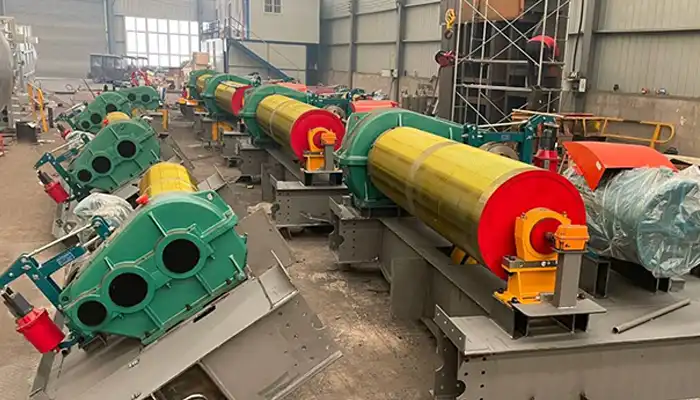
Latest project
32/5 Ton Overhead Crane Sale in India: Case Study
Free consultation to Confirm Parameters & Specifications and Get
Latest Crane Price & Crane Rate.
- Types of overhead cranes : _______?
- Optional: Overhead travelling crane, goliath gantry crane,Slewing jib crane, Single girder or double girder crane,small portable crane or kbk crane, etc.
- Capacity of overhead crane: _______?
- Optional: 0.25ton, 0.5 ton, 1 ton, 2 ton, 3ton, 5 ton, 10 ton,15ton, 20ton, 25 ton, 30ton,35ton, up to 550ton, etc.
- Crane span & lifting height : _______?
- Crane travelling length : _____?
- Control of overhead crane:_______?
- Optional: pendant/ remote/cabin control
- Voltage supply of overhead crane:_____?
- Eg,: 380V50/60HZ,3Phase or others,etc.
- Application/usage of crane:_______?
- Eg,: Steel mill, ,injection mold, cement,stone, concrete,granite, general manufacturing, etc.
Just leave a message via the contact form and our hoist and crane engineer will contact you with in 24working hours.
Get In Touch
